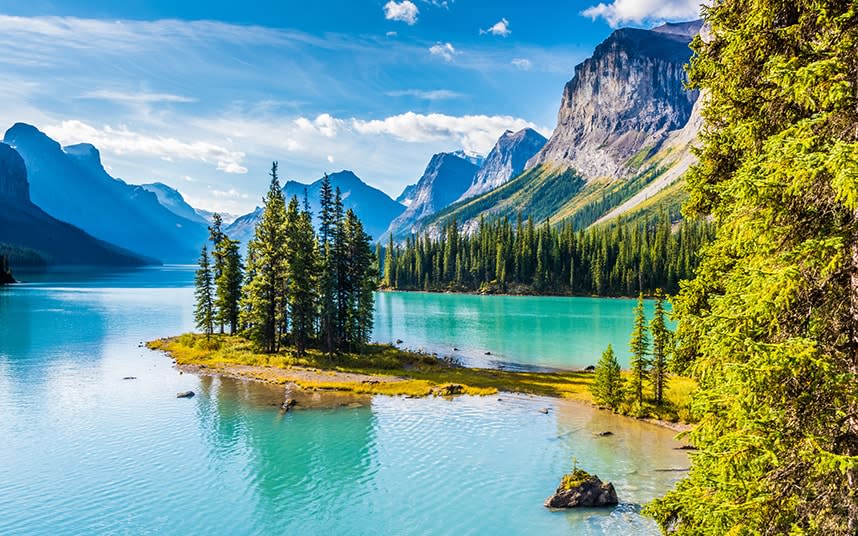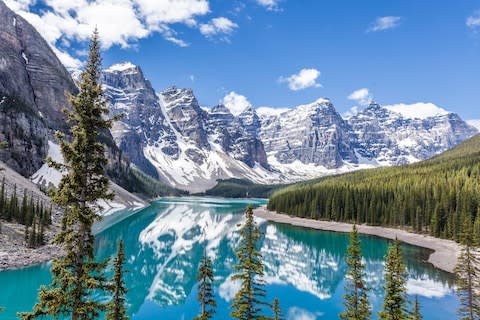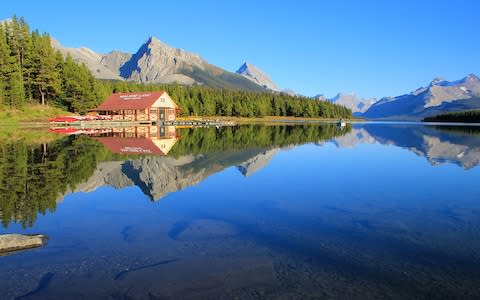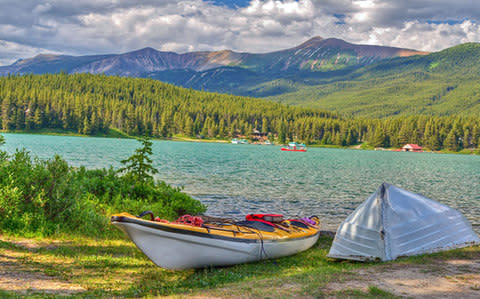'I hate doing the ordinary thing' – the unlikely female pioneer who charted the remotest corners of the Rockies

It was a glorious day down by the Curly Phillips Boathouse. The sky was cloudless; the breeze, barely a whisper, left the water unruffled and mirroring the mountains around. Maligne Lake’s northern tip, its only road-accessible point, was a traffic jam. But standing there, looking south down this brilliant-blue sliver held fast between ice-licked peaks, I didn’t much mind. I had planned an escape.
Kayaks loaded, my boyfriend and I pushed away from the little beach and all the people, slicing into the picture-perfect Canadianness with our bright yellow-red prows. The only way to access the far reaches of 14-mile-long Maligne is by boat. While small cruisers do putter to Spirit Island, midway along the lake, we had decided to paddle there ourselves, to sleep on the lake shore – just as Mary Schäffer Warren did, more than a century ago.
Born into a wealthy Quaker family in Philadelphia in 1861, well-educated, well-to-do Mary became an unlikely backcountry pioneer. She first visited the Canadian Rockies in 1889 with her botanist husband and was immediately bewitched. After he died, she continued to explore this then little-known wilderness, at a time when “the ordinary woman… is much more efficient in parlour adventures than on long hard trails”. Not so Mary. As she once wrote: “I hate doing the ordinary thing.”

In 1908 she mounted an expedition to a remote lake in an unexplored valley, spoken of by indigenous people but unknown to anyone else: Maligne Lake. Mary became the first white person to set eyes on this “string of pearls” and, three years later, the first to document it – although Mary was not a trained surveyor, and women were forbidden to even accompany such journeys at the time, she was entrusted by the Geological Survey of Canada to scientifically record Maligne.
Mary went on to make many trips into the mountains, documenting the wilderness she so loved, encouraging others to visit and helping popularise tourism to the Rockies. She once wrote: “There are some secrets you will never learn… some joys you will never feel… heart thrills you can never experience, till… you leave the world, your recognised world, and plunge into the vast unknown.” Like Mary, we were taking the plunge.
Unlike Mary, I was in a skirt (albeit of the Neoprene kayaking kind). In the early 20th century, slightly less sports-friendly skirts for women were the norm. A Banff newspaper wrote that “pants are made for men and not women; women are made for men and not for pants”. But Mary thought this nonsense – once away from civilisation, she’d pull on her breeches. And when she gave talks to inspire other women, her advice was always to “leave skirts behind and use a pair of stout bloomers. The walk… loses one-half the fatigue with the freedom thus obtained”.

I’m no expert paddler but, unhindered by any restrictive garments, I soon found a rhythm, pulling happily against the millpond. Sitting so low, I felt naught but a flimsy water strider, insect-sized in this vast cathedral of nature. We passed the odd fishermen, bobbing in their crimson canoes; I waved greetings, but they were all engrossed in their tasks, lines cast, fingers alert to the slightest tweak.
It was eight miles to Fisherman’s Bay, where we would camp for the night, but we hauled up before that for lunch on a shingle beach. As we ate enormous Albertan sandwiches with wet fingers, a motorboat heading to Spirit Island went by, its wake briefly turning the lake’s gentle lapping into loud slaps, like enthusiastic applause echoing between the mountains. As we started to make a move, a golden eagle on a nearby stump stirred, flapped its great brown wings and swooped away.
The lake shore was a constant fascination. Trees – some straight-backed, some stooped, some weather-gnawed – formed a curtain behind which might lurk moose, elk, black bear and grizzly. But not today. Instead we saw only little grey jays, with their dark beanies and white earmuffs, trilling from the branches. My partner paddled ahead, like the lead goose in a wedge, his kayak creating a perfect V on the glassy water. I followed at a distance, distracted by the glaciers clogging the mountains on either side.

Ahead, the shoreline wiggled; it appeared the lake was coming to an end. But this was Sampson’s Narrows – according to Mary, “the finest view any of us ever beheld in the Rockies” – only halfway along Maligne. Mary named this deceptive taper after Sampson Beaver, the indigenous Stoney man who’d seen Maligne – which he called “Chaba Imne” (Beaver Lake) – when he was a boy; it was his crude sketch map that Mary followed.
Mary’s personal approach to nomenclature didn’t go down well in all quarters. Certain Alpine Club gents felt the likes of Sampson, as well as Mary’s guide (and future husband) Billy Warren and assistant packer Sid Unwin were “not illustrious men” and so prominent topographical features should not bear their names. But ultimately Mary’s labels were kept. As we sculled through Sampson’s tight squeeze, the double-headed peak of Mount Unwin rose to our right, Mount Warren poked up on the left.
Our simple campsite was tucked into a cove just beyond the Narrows. Tendrils of smoke above the pine tops and a couple of resting red-hulled canoes were all that gave it away. There were only eight pitches, well-scattered amid the privacy of scrub and trees, plus a pungent long-drop lavatory. Fellow campers were stoking fires, cracking beers, roasting meat. Our packets of dehydrated gumbo were uninspiring in comparison, reminding me of Mary’s desultory “pinole” cornmeal, with its “consistency of a mouthful of sand”. Why hadn’t we packed a hip flask of bourbon at least?

It certainly would have been good to sip something warming. The temperature plummeted with the sun. But the purity was intoxicating, with the crisp silhouette of the mountains clear against the blackening sky. After dinner we sat on the beach watching the moon glitter on the water and the stars multiply above; there wasn’t a shred of light pollution to diminish the sky’s riches. The long, mournful wail of a loon, more wolf than bird, echoed in the darkness. Then peace returned. I huddled further into my jacket. “Wilderness travel involves no lasting hardships,” wrote Mary, “only life, great broad inspiriting life.”
We left the stars, climbed into our sleeping bags and lay awake, every twig snap obviously a marauding bear. We’d stored everything of potential interest, from peanut butter to toothpaste, in the camp’s bear lockers. But what if… We woke early to find our worries misplaced. Not only had we survived both beasts and bitter cold, we found our locker – while protective against bears – not impervious to rodents. So we breakfasted on what the critters had left behind, then packed up and set off before the rest of the campsite stirred.
Launching into an as-yet unruffled Maligne, our paddle-strokes were perhaps the first human intrusion of the day. Motorboats to Spirit Island don’t start until 10am; as the island was less than a mile south, we could be there before anyone else. The chill air still held its overnight bite, but the lake was a calm, turquoise ambrosia, and we moved in respectful silence, as if in church, the only noise the splish of oars in water.

Spirit Island isn’t an island at all; rather it’s a shock of trees on a tiny land-leashed spit. It’s considered sacred by the Stoney people and an Insta-spot for everyone else. An empty jetty awaited the first influx of snappers. But by the time they arrived we’d be gone. For now, as we circled Spirit, it was just us and the squirrels.
We lingered, as Mary had done. “It took some two days to row… to the upper part of the lake and back,” she wrote. “Had not enthusiasms run so high, I think our torn and bleeding hands would have made us turn back. But all stuck to the work and found the upper part of the lake a gem indeed… No one wanted to leave the wonderful place, but we knew we must…”
As must we too. But we’ll be ever grateful to you, Mary, for showing us the way.
Essentials
Discover the World offers a six-night Rocky Mountains in Depth fly-drive, taking in Banff, Jasper and Lake Louise, from £841, including accommodation, car hire and excursions; departures June-September (01737 886131; discover-the-world.co.uk).
London-Calgary flights cost from £520 return (0871 220 1111; aircanada.com).
Kayaking is bookable with Maligne Lake Boat Rentals (from C$60 pp/ £33; banffjaspercollection.com).
The Whyte Museum in Banff has a display on Mary Schäffer Warren (C$10; whyte.org).
More info is available from travelalberta.com; pc.gc.ca

